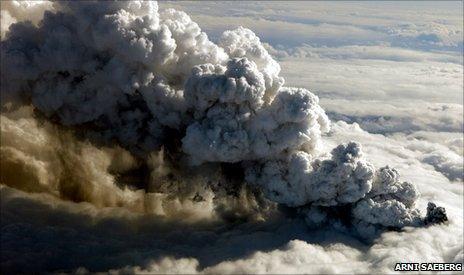Volcanic ash air shutdown the 'right' decision
- Published

The eruption shut down European airspace in April 2010
Concerns about aircraft safety during the eruption of an Icelandic volcano in 2010 were well founded, according to a new scientific study.
Ash particles from the early part of the eruption were especially sharp and abrasive, posing a possible threat to aircraft flying through the cloud.
In addition, these particles were so small they could have melted quickly inside jet engines, potentially causing them to fail mid-flight.
The work is .
The outpour of ash from Eyjafjallajokull caused the largest closure of European airspace since World War II, with losses estimated at between 1.5bn and 2.5bn euros.
Some 10 million travellers were affected by the shutdown.
The latest research was carried out by researchers at the University of Copenhagen in Denmark and the University of Iceland in Reykjavik.
Senior author Susan Stipp, from Copenhagen University, told 大象传媒 News: "I think the really important parts of it are: Number one, the aviation authorities were absolutely right in closing airspace.
"Number two, we have presented a protocol so that, if answers are needed quickly in future, they can be had.
"Then the data that are produced can be put into models to determine how far, how high and how wide the ash will spread that will be based more on fact than on guesswork."
The researchers analysed the sizes and structures of ash particles using a variety of techniques, such as atomic force microscopy, scanning electron microscopy and X-ray diffraction.
The explosive ash (L) is dominated by sharp, sub-micrometre particles; ash from later in the eruption was also sharp, but the particles were much larger
They compared ash that was ejected in the early, explosive phase of the eruption with ash from a later, more typical eruption of the volcano.
The ash ejected in the early phase was light and powdery. The more typical ash thrown out in the later stages was more granular, with the consistency of dry sand.
Icelandic researchers headed into the plume to collect ash samples
"The ash that was ejected in the first few days was so fine-grained because it was produced by an explosive eruption," Dr Stipp told 大象传媒 News.
"The meltwater from the glacier on top of the volcano ran down into the crater, chilling the magma and then the pressure from underneath caused an explosion. So the particles of ash were very fine-grained and very sharp compared to normal ash.
"The smaller the particles, the slower they come back down again. Normal ash is usually settled as it moves away from the volcano. But because the particles were so small, they travelled a longer distance from the volcano and remained in the area where the airplanes fly for a much longer time."
Modern aircraft engines operate at temperatures of around 2,000C. Dr Stipp says the glassy particles in the ash cloud start to soften at about 800C.
"By 1,000C, they are melted. And because they are so small, they melt faster. It's like when you have a drink with one big ice cube. The ice cube will stay around, but when you crush it, it melts quickly," she explained.
The sharp, abrasive nature of the particles suggested they could have damaged the bodies of aircraft and the windows - reducing visibility.
In some parts of the world, aircraft have flown around ash clouds for many years.
Stewart John, an expert on aircraft safety and a fellow of the Royal Academy of Engineering, told 大象传媒 News: "There's no way they could have allowed those aircraft to keep flying when it first happened. That was absolutely the right, safe decision, because no one knew any better.
But he added: "The amount of time it took to get going again is debatable."
In 1982, a British Airways 747 flew through an ash cloud during the eruption of Mount Galunggung in Indonesia. The ash sandblasted all the surfaces of the aircraft and caused all four jet engines to cut out when the melted ash coated their interior.
Luckily for the 263 passengers and crew, the pilot was able to re-start three of the engines after they cooled during descent. He was able to land by peeking through a 2-inch strip on the side window that had avoided sandblasting.
"I saw those engines when they were stripped down and it was quite frightening," said Mr John.
"There is no way you can fly through it if it's thick and dense. On the other hand, even when you try to avoid it, it's there in the atmosphere and it causes progressive damage [to the aircraft].
"But you can live with that because you can monitor it."